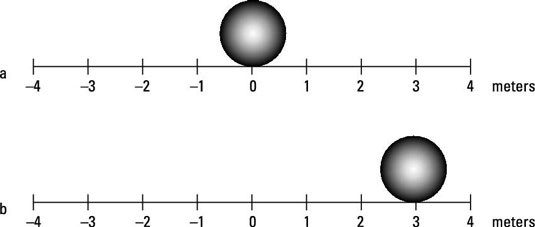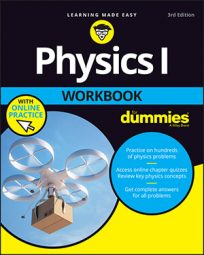Displacement occurs when something moves from here to there. For example, suppose that you have a ball at the zero position, as in the top of the following figure.

Now suppose that the ball rolls over to a new point, 3 meters to the right, as you see in bottom half of the image. The ball is at a new location, so there's been displacement. In this case, the displacement is just 3 meters to the right. In physics terms, you'll often see displacement referred to as the variable s. In this case, s = +3 meters.
Like any other measurement in physics, displacement is always expressed in units, usually centimeters or meters, as in this example. Of course, you also can use kilometers, inches, feet, miles, or even light years (the distance light travels in one year — 5,878,500,000,000 miles).
In addition to a distance, a displacement also includes a direction. For example, a displacement of 12 miles north is very different from a displacement of 12 miles south.
The following example question focuses on displacement.
Sample question
-
You’ve taken the pioneers’ advice to “Go West.” You started in New York City and went west 10 miles the first day, 14 miles west the next day, and then back east 9 miles on the third day.
What is your displacement from New York City after three days?
s = 15 miles west of New York City
-
You first went west 10 miles, so at the end of the first day, your displacement was 10 miles west.
-
Next, you went west 14 miles, putting your displacement at 10 miles + 14 miles = 24 miles west of New York City.
-
Finally, you traveled 9 miles east, leaving you at 24 miles – 9 miles = 15 miles west of New York City. So s = 15 miles west of New York City.
-
Practice questions
-
Suppose that the ball in the figure now moves 1 more meter to the right. What is its new displacement from the origin, 0?
-
Suppose that the ball in the figure, which started 4.0 meters to the right of the origin, moves 6.0 meters to the left. What is its new displacement from the origin — in inches?
Following are the answers to the practice questions:
-
s = +4 meters
The ball was originally at +3 meters and moved 1 meter to the right. +3 meters + 1 meter = +4 meters.
-
2.s = –80 inches
The ball started at 4 meters and moved 6 meters to the left, putting it at +4.0 meters – 6.0 meters = –2.0 meters with respect to the origin.
Convert –2.0 meters into inches:


